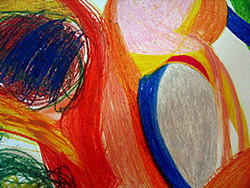
Polimorphism Of "Raw Materials" / Polimorfizam "sirovih preparata"



For her first independent exposition the young artist, Katarina Nestorovic, has "prepared" a number of paintings and drawings which all originating from the same source - scenes of variety of human and plant tissues seen through a microscope.
We can fully apply the literal histological descriptions of "raw material" in our reading of Katarina's "oil paintings on canvas". The basic substance of the bodily tissue and of the tissue of her paintings is organized in layers (by depth) or in strips (on the surface).
The density of the painted segments changes with the search for the right structure. The multiple layers of tissue are contained in the superimposition of one layer over the other. The different layers of paint, at times combined with sand and marble powder, applied by brush or the palette knife, are reflected in the texture. This texture, accompanied by an orchestration of nuances of subdued colours on the surface, give the basic substance an associative quality. It is within such a texture or such a substance or such a segment that the particular cellular forms emerge.
The polymorphism of singularly observed cells, which in their natural environment are designated by their spatial positioning, size, form, mobility, is captured in the paintings in a surface colour code: simple, reduced, silhouettes of visions, at times elaborated dance-like surface substances or like floating islands, at times rhythmically distributed in the painting, agitated, luxurious, dense.
In its transgressions the linear organism corrupts its basic substance and either dominates it or merges with it or is sucked into it. Frozen in their different developmental phases, these forms retain their signification of the archetype.
Katarina inhibits the natural physiologic function of these forms by framing them into a solid cytoskeleton of her paintings and so constructs a tissue which is resistant to novel non-mechanical pressures that, to the artist herself, remain unknown and mysterious.
The multitude of internal structures that link the details to the whole, such as the intercellular bridges which take the form of agitated, rough, frenzied, fragmented and broad linkages, emerge as a stylistically diversified yet integrated image.
This collage image of diversity points to the conceptual aesthetic and formal link of Katarina's work to that of Wols', Pollock's, De Kooning's and Fautrier's.
Apart from her marked abstract gesture imbued with energy and the variations in the execution of her visual images, Katarina succeeds in mastering the energy of the original impulse to produce dramatic and passionate paintings.
Dobrica Bisenić


